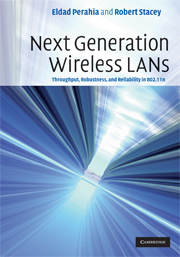1 - Introduction
Published online by Cambridge University Press: 04 December 2009
Summary
Wireless local area networking has experienced tremendous growth in the last ten years with the proliferation of IEEE 802.11 devices. Its beginnings date back to Hertz's discovery of radio waves in 1888, followed by Marconi's initial experimentation with transmission and reception of radio waves over long distances in 1894. In the following century, radio communication and radar proved to be invaluable to the military, which included the development of spread spectrum technology. The first packet-based wireless network, ALOHANET, was created by researchers at the University of Hawaii in 1971. Seven computers were deployed over four islands communicating with a central computer in a bi-directional star topology.
A milestone event for commercial wireless local area networks (WLANs) came about in 1985 when the United States Federal Communications Commission (FCC) allowed the use of the experimental industrial, scientific, and medical (ISM) radio bands for the commercial application of spread spectrum technology. Several generations of proprietary WLAN devices were developed to use these bands, including WaveLAN by Bell Labs. These initial systems were expensive and deployment was only feasible when running cable was difficult.
Advances in semiconductor technology and WLAN standardization with IEEE 802.11 led to a dramatic reduction in cost and the increased adoption of WLAN technology. With the increasing commercial interest, the Wi-Fi Alliance (WFA) was formed in 1999 to certify interoperability between IEEE 802.11 devices from different manufacturers through rigorous testing. Since 2000, shipments of Wi-Fi certified integrated circuits (IC) reached 200 million per year in 2006 (ABIresearch, 2007).
- Type
- Chapter
- Information
- Next Generation Wireless LANsThroughput, Robustness, and Reliability in 802.11n, pp. 1 - 20Publisher: Cambridge University PressPrint publication year: 2008
References
- 1
- Cited by



